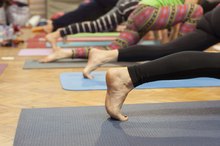What does fact checked mean?
At Healthfully, we strive to deliver objective content that is accurate and up-to-date. Our team periodically reviews articles in order to ensure content quality. The sources cited below consist of evidence from peer-reviewed journals, prominent medical organizations, academic associations, and government data.
The information contained on this site is for informational purposes only, and should not be used as a substitute for the advice of a professional health care provider. Please check with the appropriate physician regarding health questions and concerns. Although we strive to deliver accurate and up-to-date information, no guarantee to that effect is made.
Does Yoga Cause Numbness and Tingling in Hands?
Yoga focuses on creating movement through all areas of the body, but the hands play a key role in establishing balance in many inverted poses and are often extended during standing poses. The hands are also compressed in some prone or supine poses. Any of these positions could create a feeling of numbness and tingling 3. It’s possible that numbness and tingling in the hands relates to your yoga practice. If it’s bothersome, choose alternate poses that don’t cause this sensation. Ongoing numbness and tingling, however, could indicate a more serious condition that requires medical attention.
If you are experiencing serious medical symptoms, seek emergency treatment immediately.
Carpal Tunnel and Wrist Pressure
For individuals with carpal tunnel syndrome, yoga poses involving hand or wrist pressure could possibly cause numbness or tingling, although scientific research hasn’t definitively validated the connection, according to IDEA Health and Fitness Association 2. Wearing wrist splints or wraps during class could provide extra support for weight-bearing poses involving the hands and wrists. Individuals with carpal tunnel can also modify poses to relieve pressure and prevent numbness and tingling. For example, in Downward Dog pose, you can rest on the forearms rather than using your hands for support. The rest of the pose will remain the same, with your tailbone raised toward the ceiling and your straightened legs pressing into the floor. Because your torso will be shortened, walk your feet forward slightly to maintain a stretch through the hamstrings.
- For individuals with carpal tunnel syndrome, yoga poses involving hand or wrist pressure could possibly cause numbness or tingling, although scientific research hasn’t definitively validated the connection, according to IDEA Health and Fitness Association 2.
- Because your torso will be shortened, walk your feet forward slightly to maintain a stretch through the hamstrings.
Common Hand-Based Yoga Poses
What Causes Forarm Aches When Cycling?
Learn More
Poses that involve compressing the hands include Gorilla pose and Locust pose. To modify Gorilla pose, stand straight and hinge at the waist. Instead of inserting your palms beneath your feet to stretch the backs of your hands, allow the backs of your hands to rest on the mat or a block. You'll still feel a stretch, but without the weight of your body resting on your hands. In Locust pose, you'll be lying on your belly with your legs extended. Instead of lying on your arms and hands, keep them alongside your torso or extended in front. When you inhale and lift your torso, you'll still stretch the chest and develop back strength. Keep the arms engaged for strength building.
- Poses that involve compressing the hands include Gorilla pose and Locust pose.
- You'll still feel a stretch, but without the weight of your body resting on your hands.
Listening to Your Body
Mindfulness is one of the primary components of yogic philosophy. Listening to your body throughout class can help prevent overextension and injury. When you experience discomfort or pain, back off from the pose. For example, if you’re in Fish pose with your palms compressed beneath your hips and your hands begin to tingle uncomfortably, gently slide your hands out from beneath you and place them alongside your body instead. You’ll still be able to maintain Fish pose by keeping your shoulders relaxed away from your ears; the pose might require a bit more core strength since you’ll no longer be leaning against your elbows for support.
- Mindfulness is one of the primary components of yogic philosophy.
- You’ll still be able to maintain Fish pose by keeping your shoulders relaxed away from your ears; the pose might require a bit more core strength since you’ll no longer be leaning against your elbows for support.
Other Possible Causes
Yoga Spine Alignment
Learn More
Yoga might not be to blame for numbness and tingling in your hands 3. Nerve injury or circulation problems are other possible causes for this sensation, according to the U.S. National Library of Medicine 3. Radiation therapy, diabetes, stroke or thyroid issues could also be the cause. Upper-body tension can also cause your hands to feel numb or tingle, according to the "Yoga Journal." Thoracic outlet syndrome, caused by improper posture and repetitive stress, can compress or overstress the nerves running from the top of your rib cage to your hands. If you’re experiencing chronic, uncomfortable numbness and tingling in your hands, talk with a doctor to determine your next steps.
- Yoga might not be to blame for numbness and tingling in your hands 3.
- Thoracic outlet syndrome, caused by improper posture and repetitive stress, can compress or overstress the nerves running from the top of your rib cage to your hands.
Related Articles
References
Resources
Writer Bio
Morgan Rush is a California journalist specializing in news, business writing, fitness and travel. He's written for numerous publications at the national, state and local level, including newspapers, magazines and websites. Rush holds a Bachelor of Arts from the University of California, San Diego.









